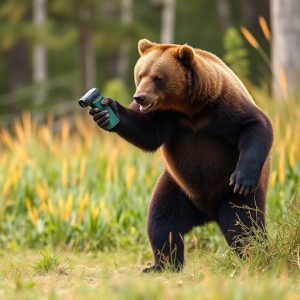Alaska Hiking: Safeguarding Against Bears with Optimal Repellent Storage
In Alaska, understanding bear encounter risks is crucial for hikers due to grizzly and black bears……..
In Alaska, understanding bear encounter risks is crucial for hikers due to grizzly and black bears. Mitigate these dangers with proper storage of bear repellent, especially maintaining the proper temperature (between -20°F and 120°F) for maximum effectiveness. Follow Alaska Department of Fish and Game guidelines: stay alert, make noise, carry bear spray, and know its correct use. Select repellents considering environmental factors and personal needs; test beforehand. Ideal storage conditions are 50-70°F (10-21°C), away from direct sunlight and extreme heat/cold. Always consult product labels for specific guidelines to ensure peak potency.
Alaska’s vast wilderness offers breathtaking landscapes but also presents unique challenges, especially when hiking. With a high risk of bear encounters, ensuring you’re prepared is vital. This guide explores the essential aspects of hiking gear in bear country. We delve into understanding Alaska’s bear behavior and regulatory guidelines to ensure safety. Choosing the right bear repellent, considering storage temperature for peak efficacy, is crucial. By following these steps, hikers can navigate Alaska’s trails with confidence and peace of mind.
- Understanding Alaska's Bear Encounter Risks and Regulatory Guidelines for Hiking
- Choosing the Right Bear Repellent: Factors to Consider for Optimum Effectiveness
- The Crucial Role of Proper Storage Temperature in Maintaining Bear Spray Efficacy
Understanding Alaska's Bear Encounter Risks and Regulatory Guidelines for Hiking
In Alaska, understanding bear encounter risks is crucial for any hiker. The state is home to both grizzly bears and black bears, and encounters can vary greatly in frequency and intensity depending on the region and time of year. Hiking in areas known for bear activity requires specific precautions, with one of the most effective being proper storage of bear repellent. Bear spray, a common defense mechanism, should be stored at the proper temperature to maintain its effectiveness. Extreme heat or cold can degrade its active ingredients, so it’s important to follow manufacturer guidelines.
Regulatory guidelines for hiking in Alaska emphasize responsible recreation and wildlife safety. The Alaska Department of Fish and Game offers extensive advice on preventing bear encounters and responding safely if one occurs. This includes staying alert, making noise while hiking to deter bears, carrying bear spray, and knowing how to use it properly. Adhering to these guidelines not only ensures a safer outdoor experience but also helps protect both hikers and Alaska’s iconic wildlife.
Choosing the Right Bear Repellent: Factors to Consider for Optimum Effectiveness
When selecting a bear repellent, understanding the environmental factors and your specific needs is key to ensuring its effectiveness. One critical aspect is considering the proper temperature range for storage, especially if you’re hiking in varying climates. Bear spray typically works best when stored between -20°F (-29°C) and 120°F (49°C). Extreme heat or cold can reduce its potency, so it’s essential to check product guidelines and store your repellent accordingly.
Other factors to contemplate include the type of bear you’re most likely to encounter—black bears are generally less aggressive than grizzlies—and personal preference for spray or other repellents like noise makers or light devices. The concentration of capsaicin, the active ingredient in most bear repellents, varies, impacting its reach and potency. Always test your chosen repellent before setting out, ensuring you understand its application technique and how it works to keep you safe during your hike.
The Crucial Role of Proper Storage Temperature in Maintaining Bear Spray Efficacy
When it comes to bear repellent hiking gear, proper storage temperature plays a crucial role in maintaining the efficacy of your bear spray. Extreme temperatures can degrade the active ingredients in bear spray, rendering it less effective when you need it most. To ensure optimal performance, store your bear spray in cool, dry places, typically between 50°F to 70°F (10°C to 21°C). Avoid leaving it in hot cars or direct sunlight during extended periods, as these conditions can accelerate the breakdown of the spray’s components.
Regular temperature fluctuations can also impact the spray’s integrity, so consider using insulated bags or containers when transporting bear spray. Additionally, check the product label for specific storage recommendations from the manufacturer to ensure you’re following best practices for maintaining its potency and reliability in the field.
When hiking in Alaska, understanding bear encounter risks and adhering to regulatory guidelines are essential. Choosing the right bear repellent, considering key factors for effectiveness, and ensuring proper storage temperature for bear spray are vital steps to enhance your safety. Remember that an informed hiker is a safer hiker, so always stay prepared and navigate Alaska’s wilderness with confidence.


